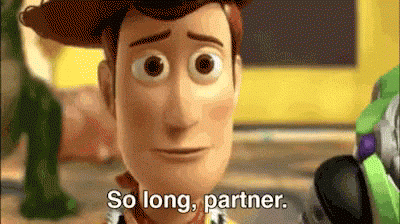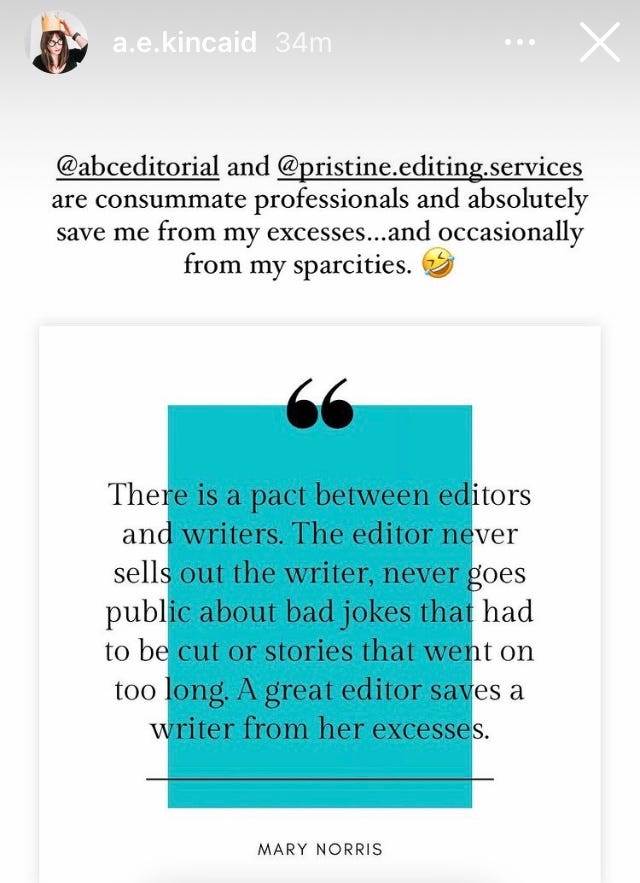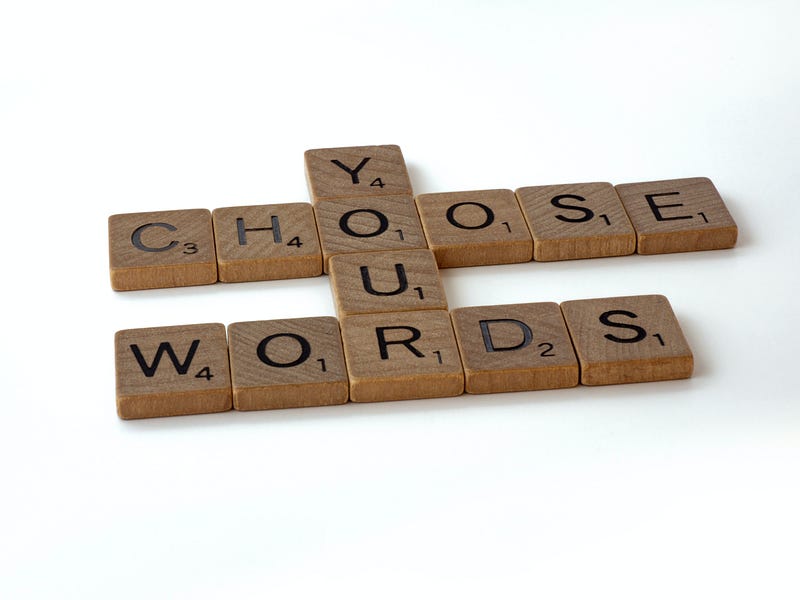I Need to Make Sure You Know This One Thing About Editors
Recently, there was yet another round of layoffs in the editing world.
While it’s just the latest event in a yearslong trend, I wanted to say something about it nonetheless.
So I dropped work on my website redesign — coming in mid-September! — to hit you with this important broadcast … slash rant.
Here it is.
The first roles media companies tend to cut in times of financial struggle include copy editors.
These companies don’t want to reduce the quantity of content they publish. Unfortunately, that often means reducing the quality instead.
Last week the Texas Tribune laid off 11 employees, including its entire copy desk. (So long, copy editors who help to make sure the news is clear and accurate!)

In June of this year, the Los Angeles Times cut 74 employees, and nearly a third came from news and copy editor ranks.
The trimming of editorial staff has been happening for years and years.
I was leading the copy desk at Time Out in 2017 when The New York Times cut its copy department, letting go of more than 100 copy editors.
The same thing is happening in the indie book world.
When times are tough, self-publishing authors can’t afford every round of editing. So they pass on a copy edit or proofread, or they combine edits.
(You all know how I feel about combo line and copy edits.)
I understand that, and I would much rather you share your stories with the world than not at all.
But I just want to make sure you know one thing:
*Copyediting and other forms of editing are important. They provide value. They provide quality assurance.*
And they do so across industries, increasing sales and readership.
Women are 81% less likely to buy a product advertised with spelling or grammar errors, and 77% of men agree.
Likewise, readers reported that poor writing, bad writing, grammar, spelling errors, mistakes, and language cause them to stop reading a book.
Copyediting upholds the integrity of journal articles, one study found.
Participants in another study “gave higher ratings to journalistic stories that had been edited than those that hadn’t.”
All of those surveys and studies show the efficacy of human editing, not AI or editing software — which is another important broadcast/rant I’ll grace you with later.
That’s all, folks.
Cheers,
Jaime
P.S. If you 100% believe in the power of editing and want me to edit your next project, don’t hesitate! Fill out this form.
Enjoy this post? Buy me a coffee in support.
Hi, I’m Jaime, editor and owner of Pristine Editing LLC. To get to know me better, and for more editing tips, sign up for my quarterly email newsletter! You can also follow me on LinkedIn and Instagram. And don’t miss out on my free style guide template.
A Roundup of My Favorite Quotes from ACES Accelerate
Nuggets of wisdom from writers and editors to other editors
ACES Accelerate was a virtual conference held by ACES: The Society for Editing, of which I am a member. There was so much to take away from the sessions at this conference that I could write many a blog post in reaction (coming soon!), but I wanted to share a quick roundup of my favorite quotes from a few presenters.

Photo by
on
Jenny Lawson, aka The Bloggess, is a blogger turned NYTimes-bestselling author who was the keynote speaker at ACES Accelerate. She had us laughing throughout her whole speech yet at the same time shared poignant insights on the writer-editor relationship, which is the exact charm of Jenny Lawson.
Cara Reedy, director at Disabled Journalists Association, and Wendy Lu, a senior staff editor at The New York Times, presented on avoiding disability euphemisms in the news. A couple points Reedy made stuck with me.
Lisa McLendon, who runs the Bremner Editing Center at the University of Kansas journalism school, offered some gems of advice that apply to all copy editors. Both of these are golden rules of copyediting.
Enjoy this post? Buy me a coffee in support.
Hi, I’m Jaime, editor and owner of Pristine Editing LLC. To get to know me better, and for more editing tips, sign up for my quarterly email newsletter! You can also follow me on LinkedIn and Instagram. And don’t miss out on my free style guide template.
Client Etiquette: How an Editor Should Interact with a Client Always
And the recent etiquette mistake I made even though I knew better
Photo by
on
Let me tell you about a recent mistake I made as an editor.
I was doing a developmental edit of a 3,000-word blog post for a tech startup. This startup did not have its own writers; instead, it hired a service that provided a handful of writers to produce regular blog content.
My job was to ensure that these writers adhered to the voice and style of the tech startup, and that the content was error-free and engaging. I would review each post twice: first a developmental edit, then a copy edit.
During the developmental edit, I would leave comments to the writers with suggestions for improving structure and organization; simplifying or clarifying language; explaining a complex idea more thoroughly or accurately; and meeting the tech startup’s style guidelines.
The content was complicated—think artificial intelligence and sales processes—and the writers were not subject experts.
Still, after more than a month, the startup’s editorial manager and I felt that the writers were not listening to our feedback as well as they should. It seemed we were repeatedly giving them the same notes, and the writing at times was rushed and sloppy.
That created more work for me as the editor and delayed the content production timeline for the startup.
So the editorial manager sent an email to the writing service pointing out the blog posts that were weak and why they needed more attention, adding that some writers didn’t seem to be making an effort to research and understand the material. The writing service responded and promised to improve.
However, when I began to edit the next 3,000-word post that came in, I was dismayed to see that many of the same issues remained.
One particular section of the post, a large paragraph, not only didn’t address our previous feedback but also just didn’t make sense. The writer clearly didn’t understand the tech or even the industry of the startup, and as a result, the sentences were vague and confusing and the information shared was incorrect.
I sighed, then highlighted the section and left a comment: “This isn’t working. The writer doesn’t seem to understand the subject matter. Please fix.”
That comment unleashed the kraken.
https://media.giphy.com/media/3ogwFUjNax6RYPvJm0/giphy.gif
The owner of the writing service wrote a furious response. He said my comment was disrespectful and unhelpful (to summarize a much longer rant).
And you know what? He was right.
I had forsaken a cardinal rule of editing that I had learned long ago:
Always be kind and helpful in comments to the writer.
Etiquette demands that an editor should always be conscious of tone of voice when interacting with and providing criticism to the writer.
We have to show respect for the people who create content out of nothing! Being a writer is challenging—especially when you’re writing about something of which you know nothing (a common occurrence for a professional writer).
Beyond that, I knew very well that comments to writers should never just point out problems. They should always suggest a solution in tandem.
What is a writer supposed to do with a comment that says “This doesn’t work” but doesn’t provide a way forward? Maybe that writer struggled to get to that point, simply didn’t know what to do to strengthen that section, and just needed some guidance. In that case, receiving a comment like mine would be frustrating and demoralizing.
Leaving helpful comments is a practice I uphold with every client I have, and I also firmly believe it’s a great way to filter out editors who aren’t a good fit for you.
If your editor isn’t supplying you, the writer, with comments that not only point out the problem but also offer an actionable solution or next step—in a pleasant, respectful tone of voice—then it’s time to look for another editor.
Which is why I was disappointed in myself for leaving such a short comment. I knew better.
Sure, the editorial manager and I had already given the writing service a lot of feedback. That was why I left the comment I did—I imagined the writer would make the connection between my comment and that feedback.
After all, the writer is responsible for consuming and listening to all constructive criticism in order to do better in the next round.
But a comment in a Google doc was not the place to get snarky.
I should have listed all the reasons the section did not work and share a suggestion. And then the editorial manager could have stepped in to have a larger conversation with the writing service about meeting the tech startup’s needs.
As an editor who also writes professionally, I recognize how important it is to have an editor who respects the work you put in to creating content.
And that respect should shine through in every interaction writers have with their editors.
Enjoy this post? Buy me a coffee in support.
Hi, I’m Jaime, editor and owner of Pristine Editing LLC. To get to know me better, and for more editing tips, sign up for my quarterly email newsletter! You can also follow me on LinkedIn and Instagram. And don’t miss out on my free style guide template.
The Sanctity of the Writer-Editor Relationship
There’s an unspoken pact between writers and editors.

Photo by
on Unsplash
Recently I rewatched Mary Norris’s Ted Talk—for possibly the 20th time—and, as always, a new gem stood out to me. Norris, former New Yorker copy editor, touched on the writer-editor relationship:
There is a pact between editors and writers. The editor never sells out the writer, never goes public about bad jokes that were cut or stories that went on too long. A great writer saves an editor from her excesses.
Listening to this quote had me nodding along in agreement, and it made me want to explore the writer-editor relationship further for the sake of my clients—or for potential future clients who are currently hesitant about working with an editor.
Writers, especially new writers, may think that sharing their work with an editor will “out” them as a…bad writer. Someone who doesn’t deserve to be among the ranks of those who call themselves scribes.
That’s why I want to share a key lesson I learned early on in my career as an editor:
Everyone needs an editor. Everyone.
It matters not in the slightest whether you are a naturally strong writer or even a great editor! Whatever you wrote can be improved by another pair of eyes, and further still by a pair of professional eyes. I’ve been a professional editor for eight years, and I still ask others for feedback and edits on important work.
As someone who also writes, I take great comfort from this lesson. I no longer fear criticism of my written work because I know every writer receives criticism. It’s just part of the process.
I’m not embarrassed by the “faults” in my writing because I’ve seen it all as an editor—and I am being completely honest when I say that I don’t judge as I edit. I never think, Oh, jeez, a dangling modifier, don’t they know anything about syntax? or Wow, that’s a major plot gap, how could they have missed something so egregious?
Furthermore, I never assume writers don’t know the rules of grammar, spelling, punctuation, etc., if their work includes such an error.
Editors know that writers encounter all kinds of obstacles in the writing process: deadlines, heavy workload, lack of inspiration, low expertise in the topic, simply having lived with a piece of work too long to be able to see it clearly…
The act of writing is challenging. What’s more, writing and editing use two different brain modes, as Anupam Krishnamurthy says in his post “Separate your writing from your editing”:
Our brain alternates between working in the diffuse mode and the focused mode. The diffuse mode is responsible for open, creative thinking.… The focused mode…helps us determine logic, structure and sequence.… For a given task, the brain can be either in the focused mode or the diffused mode. Mixing up our writing and editing causes us to switch between these two modes, breaking the flow of our thought.
For writers to get the words on the page, they have to release the unrealistic goal of making it perfect the first time around.
What writers need to know about editors is that we have a profound respect for you. Because it takes determination and creativity to write. Editors react to the text. Writers create it from nothing.
This lays the foundation for the writer-editor relationship.

A little client love from a book author
The editor never sells out the writer because that would just be…blind to the writing process.
The writing process is a cycle of prewriting, drafting, revising, and editing on repeat until the work is the best version it can be.
Just as our private thoughts are not who we really are, incomplete drafts do not determine the writer. What matters is what we put out into the world: the final draft.
Editors understand that, which is why it doesn’t faze us to make even hefty changes and suggestions to a writer’s work—be it a manuscript, blog post, thought piece, anything.
Some writers may struggle with the idea of ownership when it comes to their work. If an editor gives me tons of feedback or makes lots of changes, is the work even my own at that point?
Yes, it is.
The writer is the creator, and the editor is the reactor. And the editor will never share what the excesses, gaps, or errors were in the drafts because, frankly, it doesn’t matter.
Hi, I’m Jaime, editor and owner of Pristine Editing LLC. To get to know me better, and for more editing tips, sign up for my quarterly email newsletter! You can also follow me on LinkedIn and Instagram. And don’t miss out on my free style guide template.
Can an Editor Also Be a Writer?
Yes. Here’s why being a “sometimes writer” makes me a better editor.

Photo by
on
Acquaintance: “What do you do?”
Me: “I’m an editor and sometimes writer.”
That’s been my response for a few years now.
Editing is my main gig. Most of my work over the past decade has been focused on editing. Most of my clients use me for editing, not writing.
Still, there’s never been a time in my career when I was doing only editing or only writing. The two are inseparable.
https://media.giphy.com/media/iFsCkq1xk05l4DbgrY/giphy.gif
My first job after undergrad was as a reporter and staff writer for an industry newspaper. The team was so small—me, plus another journalist—that he and I also proofread each other’s work.
As an editorial intern at Food52 in NYC, I would regularly write and line-edit articles. (You can view my posts here.) At Well+Good, I line-edited five articles a day and occasionally pitched ideas for travel tips and essays.
When I began my role as copy editor at Time Out, my daily responsibilities revolved around editing. But it was simple to pitch a story idea to the editors of each vertical—they were only a desk away, and everyone was encouraged to contribute to editorial brainstorm sessions. Sometimes vertical editors needed all hands on deck to write a feature, or their regular freelance writer wasn’t available and they were desperate for help.
So, while I was at Time Out, I wrote blog posts and theater and restaurant and hotel and bar reviews, and I contributed to features. (Plenty of magazine copy editors occasionally write something—for instance, The Atlantic’s copy chief, Janice Wolly.)
Later, as a freelancer, I routinely wrote case studies for a client who then asked me to developmental-edit other writers’ case studies because mine were strong. #humblebrag
In the freelance world, a huge emphasis is placed on niching.
New freelancers are told that the best way to attract clients is by choosing a niche—the one thing you are an expert in (or say you’re an expert in). Advanced freelancers advise that a niche is key to charging more money because you can claim to be an expert, the best in the biz in that one thing.
Consequently, people looking to hire a freelancer are told to avoid jack-of-all-trades. It’s a red flag if a freelancer claims to be good at too many things.
I agree—to some extent.
But I firmly believe that being a writer makes me a better editor.
By writing, I remember the writer’s perspective. I’m reminded of how frustrating and tedious the writing process can be and how much effort and dedication it takes.
More important, I recall what it feels like to receive criticism of my writing. And that makes me a more empathetic editor.
I aim to be sensitive, clear, and specific in comments to writers and authors because I know what it’s like to receive disrespectful, vague, ineffectual feedback on writing I worked hard to produce.
As a writer, I appreciate constructive criticism on what could be better in my work, and positive feedback floods me with motivation. It gives me the fuel I need to get to the next draft. And that’s exactly what I want to inspire among my clients, authors and content producers alike.
When I polled other editors on Twitter, 42.9% said they too also write, while 40% of editors said the same in an Instagram poll (only seven people voted, but still!).
Of course, I’ve met excellent editors who simply don’t like writing.
But I feel that it gives me a competitive edge and makes me more valuable to my clients. Plus, I enjoy exercising the writing muscle!
So, in honor of Freelance Writers Appreciation Week (Feb. 13–19), here’s to all the other editors out there who also write.
Hi, I’m Jaime, editor and owner of Pristine Editing LLC. To get to know me better, and for more editing tips, sign up for my quarterly email newsletter! You can also follow me on LinkedIn and Instagram. And don’t miss out on my free style guide template.
Editorial Style Guides Are a Helpful Resource, Not Irrefutable Law

Photo by
on
Recently I saw a tweet that broke my copyediting heart:
https://twitter.com/DanaHerra/status/1404463541327912963?s=20
This comment is a perfect illustration of why many people fear copy editors.
Writers, journalists, and others think copy editors are too strict, too critical, too literal. We’re zealots of the style guide, which we champion as gospel, never deviating.
And if making our clients strictly adhere to a style guide to the point that it extinguishes all character, voice, and feeling from their work—so be it.
https://media.giphy.com/media/xT0GqfvuVpNqEf3z2w/giphy.gif
That’s an exaggeration, but it’s not far from the common perception. And I understand why that perception exists.
The style guide is copy editors’ primary resource. They likely reference it a dozen times or more daily. It contains not only rules for grammar, punctuation, and syntax but also style guidelines specific to an industry or organization.
The style guide is key to maintaining consistency across all content channels, which conveys professionalism and upholds the brand voice.
Most newspapers abide by Associated Press. The publishing industry adheres to the Chicago Manual of Style. Beyond those, every organization often has its own house style guide that further delineates its preferences.
As a copy editor, I love a good style guide. Every time I onboard a new client, I create a house style guide for them, unless they already have one. It helps me to figure out my client’s preferences and adhere to them in every piece I edit. It can also be shared with writers or other stakeholders involved in content production.
NASA puts it nicely:
“The purpose of style guidelines is to achieve consistency in prose style and usage so that readers can become absorbed in the content and avoid being distracted by curiosities in form. Authors and editors likewise will have an easier task when they compose and revise by the same set of rules.” —NASA style guide
However, I admit that there is such thing as overdependence on a style guide. They should be a helpful resource, not irrefutable law.
Let me tell you a story about the dark consequences of unflappable dedication to a style guide.
For one magazine I copyedited for, I managed a 274-page style guide. I inherited it: It was likely started decades earlier by the magazine’s first copy editor and had been added to over time.
Adapting to that style guide took me forever. Months after being hired, I was still uncovering new style rules, which meant I had not been implementing the “correct style” in that time.
The abrupt changes I made to adhere to the new rules I had uncovered made the other editors and writers grumble: “You hadn’t been making us do this before.”
Sometimes I even found contradictory rules within that style guide because it had passed through so many hands.
The irony is that style guides are meant to ensure consistency, but when they become as unwieldy as 274 pages, they are almost a detriment to it.
Which is why I felt so in accord with this tweet—the one that inspired the tweet above that broke my heart:
https://twitter.com/optimized3x/status/1404454843700465674?s=20
This is especially true today with multimedia content. Traditional style guides were created for print. That doesn’t make them irrelevant, but they do need to be able to evolve with modern language and media. So do copy editors.
Copy editors realize this. We are trying to be more flexible. I adjust my style of editing depending on the industry, audience, and medium. For example, it may not be okay to use incomplete sentences or slang in a white paper. But that’s practically requisite for social media and blogs.
When I create a style guide for clients, I don’t immediately force them to stick to AP or Chicago style. I ask them three things:
https://twitter.com/PristineEditing/status/1404490791280693260?s=20
Then I ensure consistency throughout the document. As I edit, I compile notes about repeat issues and preferences in a casual style guide.
My main goal in copyediting is readability. Will the audience read your piece and understand, using a minimal amount of brain power, what you are saying? Are you, the writer, saying what you think you’re saying?
Consistency is part of ensuring readability. A copy editor shouldn’t remove something the writer loves—such as killer lede—only for the sake of an arbitrary rule.
However, a caveat:
The copy editor should be strong and push back when something just doesn’t make sense and needs to be changed.
There’s a lot that copy editors can do to fight our “bad cop” persona (as longtime New Yorker copy editor Mary Norris describes us in her Ted Talk).
But applying a critical eye to others’ words is intrinsic to our role, and it’s inevitable that our notes are going to make someone unhappy at some point.
As long as your edit or change has a valid reason behind it, then most people will be receptive to it.
Hi, I’m Jaime, editor and owner of Pristine Editing LLC. To get to know me better, and for more editing tips, sign up for my quarterly email newsletter! You can also follow me on LinkedIn and Instagram. And don’t miss out on my free style guide template.
Why Book Authors Should Beware Combo Line and Copy Edits

Photo by
on
When I became aware of how many editors offer combo line and copy edits, I was aghast.
Because combo line and copy edits are the worst. And I am suspicious of editors who tout them as a quality offering.
This is a controversial opinion, I know.
When I recently shared a poll in Instagram Stories (pristine.editing.services) asking editors and authors whether they liked combo line and copy edits, 75 percent said yes! Many editors with decades of publishing experience offer them.
However, in my experience, a combo line and copy edit is bad for both the author and the editor. And there are editors who agree with me. Just check out the comments of my Instagram post.
I completed a few combo line and copy edits when I worked for a book-editing service provider about two years ago. I’ll never do another.
To the editors who say that line editing and copyediting complement each other well because they are both sentence-level editing, I say:
https://media.giphy.com/media/1BdtqhrkXU59XURZNN/giphy.gif
The goals, rules, and style of the two types of editing could not be more different. Calling them both sentence-level editing is about as misleading as saying your life coach is in the same field as your heart surgeon because they both care for your well-being.
Line editing is still in the realm of developmental or structural editing. Copyediting happens after the developmental or structural editing is over — it’s part of the process of preparing the manuscript for publication. Major changes can be made in line editing. They should definitely not be made in copyediting.
Line editing is interpretive. Line editors are free to change whatever they want in the name of smooth flow and lyricism.
Copyediting is technical. Expert copy editors will only change what is necessary for correct grammar, punctuation, spelling, syntax, repetition, and style. Otherwise, they don’t touch a word—even if they personally don’t like how something is phrased.
Line editing and copyediting are separate processes for a reason.
https://media.giphy.com/media/h5ozMZZrfMJR1Do4aK/giphy.gif
The books for which I did a combo line and copy edit needed a lot of work.
I rewrote a significant amount and left a lot of comments for the writer — which is totally okay! That’s what developmental editing is for.
What wasn’t okay was that I was expected to turn a messy manuscript into a nearly publication-ready document. That’s problematic because:
It sets unrealistic expectations and is a ton of work for the editor. Because the editor is trying to accomplish so much, a combo line and copy edit isn’t going to be as effective as separate line and copy edits. And that, of course, hurts authors.
The amount of work involved is one reason I doubt an expert editor would want to offer a combo line and copy edit. It makes me question the quality of the edit being offered. You get what you pay for.
Some of those who answered my Instagram poll said they like the combo edit because it seems natural to fix errors while line editing. That’s true! A good line editor should leave the document as clean as possible. But that’s not the editor’s № 1 priority in a line edit. And catching errors does not equate to a thorough copy edit.
As a line editor concentrates on fluid prose and improving a scene, is she also going to catch that one character’s eyes are brown on page 12 and hazel on page 132? Or that sneakily incorrect subject-verb agreement that most people would miss on a first pass? Or that non sequitur that wasn’t immediately obvious but, upon further consideration, doesn’t make sense? Or that the author wrote free reign when she meant to write free rein? Or that the character lost her keys on Wednesday, but on Friday, she says she lost her keys three days ago?
“But wouldn’t comments about timeline issues, etc., fall into the category of line editing?” asked one of my shrewd Instagram followers.
To me, weeding out lingering small plot gaps, timeline mismatches, and other hiccups is part of ensuring consistency—a golden rule of copyediting.
Perhaps addressing those issues does goes a little above and beyond a standard copy edit. That’s why I offer authors a copyediting package with margin commentary for pointing out those remaining low-level developmental concerns. The copyediting stage is an excellent time to do that because it’s the first close review of the story post-developmental editing. (Which is yet another reason the copy edit should be separate from the line edit or any other form of developmental editing.)
Line editors do deal with much larger fixes of plot gaps, timelines issues, and more. But because they’re so focused on those bigger issues and ensuring fluid prose, they just might miss the smaller stuff.
I understand that the combo line and copy edit is more tempting for independent authors financially. My guess is that editors offer the combo line and copy edit solely because it is so attractive to authors with tight budgets. And I am all for making publishing more accessible to everyone.
If a combo line and copy edit is the only way an author can afford line editing and copyediting, then do it, absolutely. It’s better than nothing.
But it seems there’s a widespread misconception that the combo line and copy edit is just as viable as separate line and copy edits. It’s not.
Also, it’s important to note that the combo line and copy edit is not necessarily cost-effective.
What happens if the line edits inspire the author to rewrite sections of the book? That happened in every combo line and copy edit I completed. The author then has to start (and pay for) at least the copyediting process all over again.
I’m sure there are exceptions to this strong opinion of mine. Perhaps there’s a reason editors offer combo line and copy edits that I just can’t see or haven’t heard.
Even as I write this post, three editors have voted that, yes, they do offer combo line and copy edits on my Twitter poll.
I welcome having my eyes opened on the subject. Comment below or send me an email at info@pristineediting.com.
Hi, I’m Jaime, editor and owner of Pristine Editing LLC. To get to know me better, and for more editing tips, sign up for my quarterly email newsletter! You can also follow me on LinkedIn and Instagram. And don’t miss out on my free style guide template.
